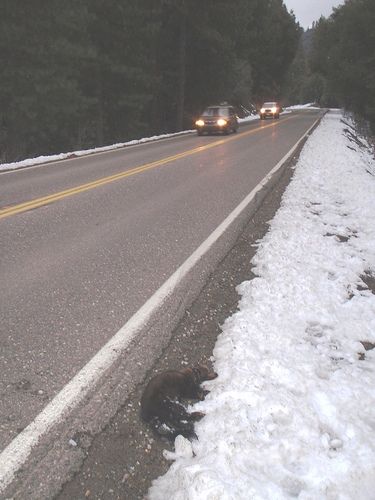Roadkill is a serious threat to rare wildlife populations
Why shouldn’t the chicken cross the road? Because statistics show it is very likely she will be run over! According to the Humane Society of the United States, over a million animals die on our roads every day.
Wildlife statistics gathered by the California Roadkill Observation System created by the Road Ecology Center at UC Davis have recorded almost 22,000 animal deaths on California roads in the last four years. Roads are an additional danger beyond those that Mother Nature already has in store for the wildlife of our state and it is one we bear the responsibility for. The loss of each animal affects its population numbers, it reproductive capacity and any babies left behind in its nests. But if an animal does not cross roads, it can result in genetic isolation in wildlife populations and loss of habitat.
For the Pacific fisher research team of the Sierra Nevada Adaptive Management Project (SNAMP), roadkill is very much a concern. They have been tracking the Pacific fisher, a nocturnal forest dwelling weasel, in the southern Sierra for the last five years. Their goal has been to identify the effects that forest thinning in may have on the fisher. In their careful tracking, they have recorded the deaths of nine of these rare animals on Highway 41, which cuts through the study area on its way to Yosemite. This is an important number considering the isolated population is estimated to be only about 300 individuals south of the Merced River; and these are only the roadkill incidents we know about.
In the team’s search for solutions to the roadkill issue, they have assembled a Wildlife-Vehicle Collision Group with the Forest Service, Yosemite National Park, Defenders of Wildlife and Caltrans to search for any possible solutions. Members of the SNAMP Wildlife Team put cameras in culverts passing beneath Highway 41 from Oakhurst to Yosemite to see if they were being used as a possible alternate route. (For details see the Sierra Nevada Highway Culvert Product, pdf). The good news is that many animals, including fisher, were found to be using road culverts to pass beneath the road, avoiding collisions with cars. This provides some hope that maintenance of the entrances and exits of existing culverts offers a safe alternative to road crossing for wildlife.



Posted by Bethany Birchridge on May 7, 2018 at 7:57 AM